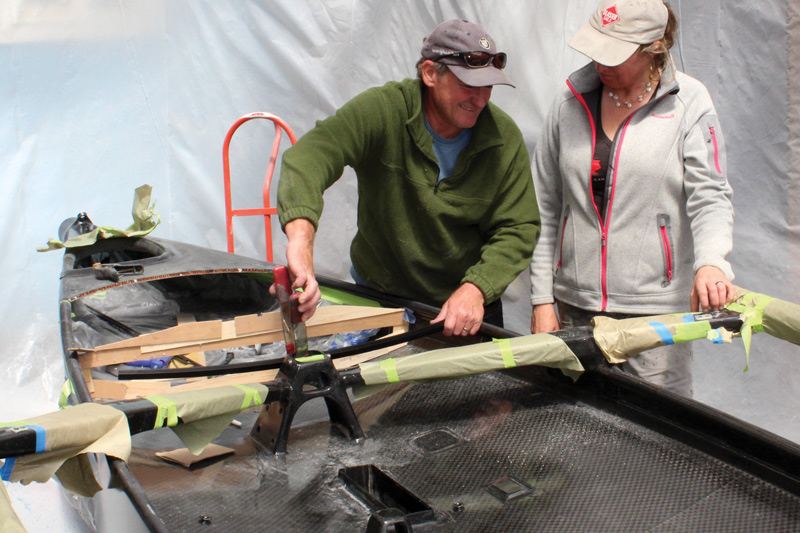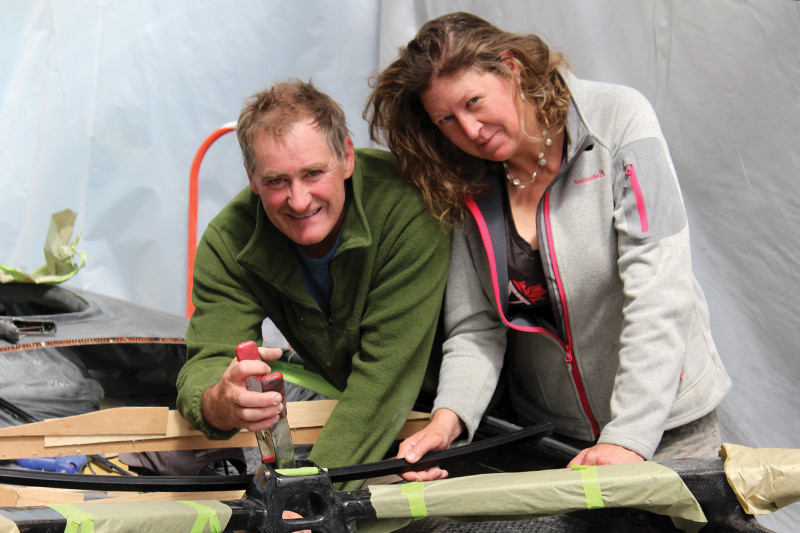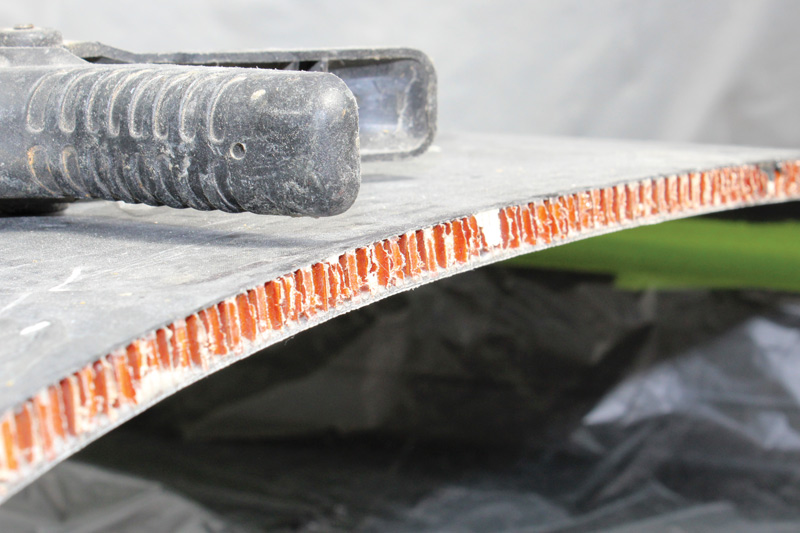Whatever has happened in my quest for innovation
has been part of my quest for
immaculate reality.”
-George Lucas
When one hears the term carbon fiber, spectacular images of sleek racing sailboats and big-money modern yachts come to mind. Carbon fiber as a building material represents the leading edge of what is possible, somehow lighter than fiberglass yet stronger than steel (and usually more expensive than both combined). The material is all the rage within the high-profile racing circuits like the America’s Cup and for those who can afford it on the recreational side. Surely with all the hype and investment from high-profile clients, top-tier carbon fiber components and builds are in the domain of big corporations and factory assembly lines, right?
 My visit to Henderson Boat Company, the Seattle shop that builds anything with composites or carbon fiber from world-class I-14 racing sailboats to satellite components, proves otherwise. Tucked among commercial canning facilities near the industry dominated shores of southern Salmon Bay, the business is housed in a modest metal structure no larger than a house that used to be the paint shed of CSR Marine when they operated at that location. There is no bustling horde of hired employees here, for Henderson Boat Company is owned and operated by a husband and wife, Kris and Kim Henderson, who also live in the shop. Don’t be fooled by the modest appearance professional talent lies within. Kris’ professional racing and design background range from designing and building America’s Cup boats to the new groundbreaking Bieker 6s. Kim was the chief engineer aboard a Dutch Harbor commercial crabbing vessel before meeting Kris and teaming up. I was fortunate enough to sit down with the dynamic duo at their shop to learn more about carbon fiber, modern building and design techniques, and the business. If you want something built to compete at the leading edge, you may want to give the Hendersons a call.
My visit to Henderson Boat Company, the Seattle shop that builds anything with composites or carbon fiber from world-class I-14 racing sailboats to satellite components, proves otherwise. Tucked among commercial canning facilities near the industry dominated shores of southern Salmon Bay, the business is housed in a modest metal structure no larger than a house that used to be the paint shed of CSR Marine when they operated at that location. There is no bustling horde of hired employees here, for Henderson Boat Company is owned and operated by a husband and wife, Kris and Kim Henderson, who also live in the shop. Don’t be fooled by the modest appearance professional talent lies within. Kris’ professional racing and design background range from designing and building America’s Cup boats to the new groundbreaking Bieker 6s. Kim was the chief engineer aboard a Dutch Harbor commercial crabbing vessel before meeting Kris and teaming up. I was fortunate enough to sit down with the dynamic duo at their shop to learn more about carbon fiber, modern building and design techniques, and the business. If you want something built to compete at the leading edge, you may want to give the Hendersons a call.
Q: Your bread and butter seems to be the racing scene. What’s unique with what you do?
Yup, racing sailboats are what we like to do best, but we’ll do all kinds of custom jobs. We build I-14s internationally, that’s a big part of what we do. As far as racing sailboats go and what we do uniquely, we take Paul Bieker’s designs and bring them to life with a carbon fiber and vacuum bagging process with high tech resins. That’s the leading edge right now.
We do a lot of custom stuff. A guy just called me and he wanted to put a water ballast system in his Melges 24. What a crazy idea! But my response is pretty much always, “Ok, get the drawings, I’ll look at them, and we’ll figure it out. We’ll do it, but we’re busy until October so you can get in line!”
Q: How about you take us from the beginning. I want to upgrade something on my boat to carbon fiber and…?
We start with measuring and designing. Right now we’re building a custom carbon fiber bowsprit, and we start by measuring the dimensions. I send my files to an outside expert to digitize the drawings with CADD (computer-aided design and drafting).
Our CADD design is done by Brad Davis up in Port Townsend. I’ll send him some files on a computer, and he can digitize the design in three dimensions. He can also cut the mold shape. Kim and I will refinish it: coat it with epoxy, wax it, clean it, and get it all polished up. Then we’re off making parts. We make the parts, the shape, fair, paint, clear coat. We do a lot of different things.
One aspect of what we do is that everything we make is 100% American made, mostly from the Pacific Northwest. We work with other maritime businesses in Hood River, Anacortes, and more depending on the job.
Q: It sounds like a lot of groundwork is laid outside of the shop, but you bring together the components as craftspeople to make a boat out of it?
Yup, basically. There’s a tight community around here. Between Kim and I, we basically work by ourselves. At times we bring in others to help out. There are lots of subcontractors around here, “I need three guys next week” kind of deal. I was one of the top people building the Cascadia, the Shumaker 87-foot boat now out of Shilshole Bay Marina. We built that boat right after we got back from America’s Cup, and there were probably 75 people working on the boat. Once we tap into the people of the Pacific Northwest, we know the painters, the wiring guys… we always have “our guy” handy. Now that the boat is done, they contact me for new pods for the electronics or what have you for the owner.
Q: How labor intensive is working with carbon fiber?
It’s about the same as fiberglass but more technical. It’s important to orient the fibers correctly. Carbon fiber is more of a structural membrane than other materials. You can’t just throw it together like mat fiberglass because carbon fiber has to utilize the directional strengths of the different weaves. You got to get it right to the T.
There are three different fibers. The first is the finish cloth, and that’s usually a 0-90 (referring to the degree of the angle of the fibers of the weave to each other). The next we call bi-axe, it’s biaxial, the layers are going 45 degrees from each other. The last layer is called unidirectional, and that’s where the fibers only run one direction and are stitched together. You basically make a sandwich of the different fibers.
Q: Do most components have all the different kinds of fiber in it?
That depends on how strong the piece needs to be. It’s really easy to overbuild something, especially in the racing world. You want to keep the weight and strength ratio just right with no excess weight. If it breaks, just make it a smidge more built next time.
According to my friend (and racing legend) Ian Murray, the rules of the perfect America’s Cup boat is that you race in the America’s Cup, you cross the finish line to win the race, and as you’re sailing to the dock, it starts to crack and sink. Just as you get to the dock and step off, it sinks behind you. Then you’ve built the perfect America’s Cup boat.
Kim and I try to work very hard not to let any of our stuff break, but that happens in this industry when you’re pushing the leading edge. At the recent European Championship it was blowing 30 to 35 knots and like half the boats couldn’t race with broken rudders, masts, etc.
Henderson

Q: How do you approach a job? Is there a process or a philosophy?
Honestly, a lot of the time I don’t even want to touch a job, but you know, I always say “we’ll figure it out, we can do it” and then start scratching my head about how to do it. It always comes together some way or another.
Q: I’ve heard about a few of Henderson Boat Company’s “other” projects. Wasn’t there some kind of house or something?
We do a lot of other things. A sailing I-14 guy who lives in Breckenridge, Colorado, called up about making a carbon fiber super camper. There are these all-terrain campers that can go anywhere or do anything, but they are these big heavy beasts of metal and whatnot. Why can’t we build one out of carbon fiber and divinycell foam just like a boat? And then design the interior to be like a sea-going boat with load cell batteries and an inverter and solar panels on the roof and LED systems and the whole thing would run itself. It’d be super light. So we built the box out of carbon fiber. We had to change our whole shop, build a 28-foot flat to vacuum down these long carbon fiber panels we had to make. It was wild.
Q: Is one of these things driving around?
Almost! They are going to pick up their I-14 and head on over. It’s going to be awesome! Each carbon fiber body we made will weigh almost nothing, like 75 pounds. Game changer. For a while we had all these flat panels everywhere and Kim kept saying we’re building flat boats now. Whatever it is, we do a bunch of diverse things.
Q: I bet you could take your racing roots to apply to all kinds of things.
Yup, this last fall we had a project from Google. They had us make a bunch of parts for this crazy “smart” tethered kite that that flies way up in the atmosphere in search of the jet stream. It has propellers on it that produces electricity that it sends back to Earth via carbon fiber rods to a wheel… it’s wild.
At the time, we didn’t know what we were making and they didn’t tell us until the very end. We built all the housings for the wheel and the whole thing is the size of that trailer. We couldn’t even tell anybody about it! Turns out we were basically making a spaceship.
I’ve also done satellite stuff occasionally with Lund Engineering (Seattle). They show up and say “hey, this is going on a satellite,”
CONTACT
• Phone: 206-790-3224
• Website: hendersonboat.com

Q: Can you speak to the Bieker 6 design and what’s in store for the Henderson Boat Company?
If there is a list of deficiencies and you as my client don’t do anything about it, the survey can be used against you in the worst-case scenario, a loss. Your boat catches on fire or something, and I’ve listed some problems with your AC system in the survey. Your insurance company is going to pull that report and try to connect the dots to pay less.
Surveying is simply grading the boat, taking all the emotion out of it, even though people are emotionally and financially incentivized to be emotional.